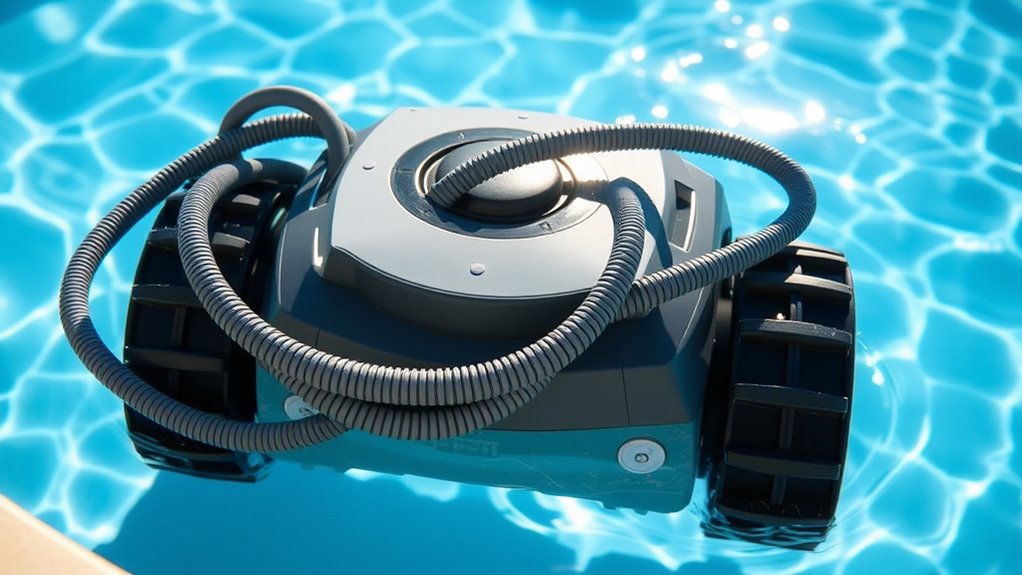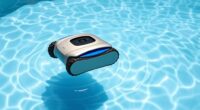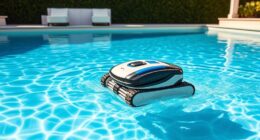To avoid issues with your suction pool cleaner, make sure you position it properly and secure all hose connections tightly. Regularly check and clean the filters, and remove debris from your pool to prevent clogs. Don’t use the wrong suction settings or run the cleaner for too long, and always follow manufacturer instructions. Proper setup and maintenance will keep your cleaner working effectively—stick around to learn more tips for the best results.
Key Takeaways
- Ensure hoses are securely connected, free of kinks, and properly positioned to maintain optimal suction and coverage.
- Regularly clean and inspect filters, seals, and hoses to prevent clogs and maintain efficient operation.
- Adjust suction and operation settings according to pool size and debris level for effective cleaning and equipment safety.
- Confirm pump and cleaner compatibility, and verify all connections to prevent leaks and suction issues.
- Follow manufacturer guidelines for setup, maintenance, and usage to extend the cleaner’s lifespan and prevent damage.
Failing to Properly Position the Cleaner
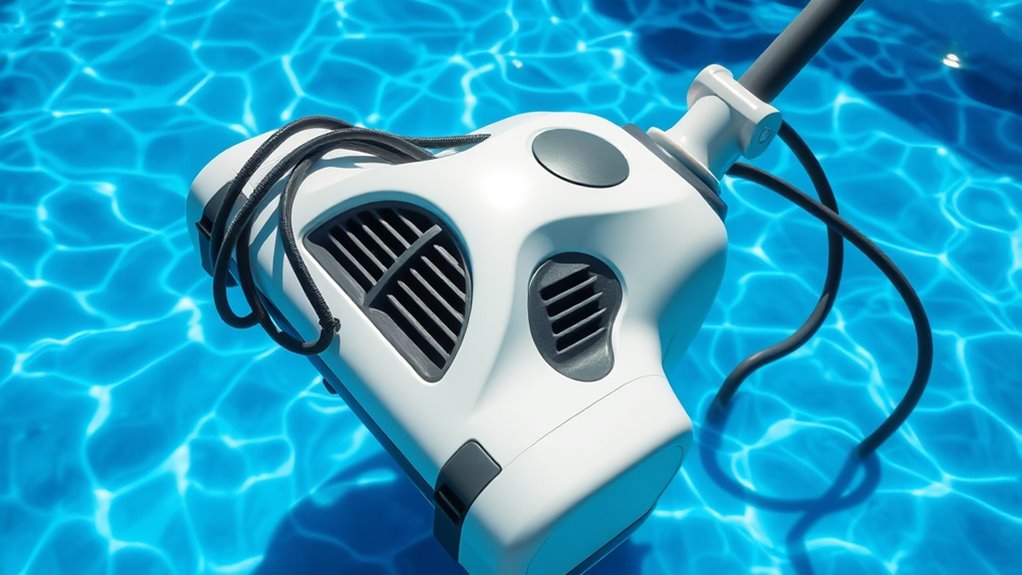
Properly positioning your suction pool cleaner is essential for effective cleaning. When you place the cleaner correctly, it can efficiently cover the entire pool surface and bottom, preventing missed spots. Make sure the cleaner’s hoses are free of tangles, and adjust the weights to ensure it stays on targeted areas. Maintaining proper pool chemical balance also plays a role; a balanced pool prevents algae buildup, which can clog filters and hinder cleaner performance. Regularly move the cleaner to different zones to ensure even coverage and avoid buildup in one area. By positioning your cleaner correctly and keeping the pool chemistry in check, you’ll reduce algae growth and keep your pool sparkling clean with less effort. Additionally, understanding how suction power and filtration systems affect cleaner efficiency can help you optimize your cleaning routine. Ensuring that your automatic pool cleaner is compatible with your filtration system can significantly improve its performance and longevity. Regular inspection and cleaning of the filter cartridges or skimmer baskets also contribute to maintaining optimal suction and filtration effectiveness.
Ignoring Regular Maintenance and Cleaning
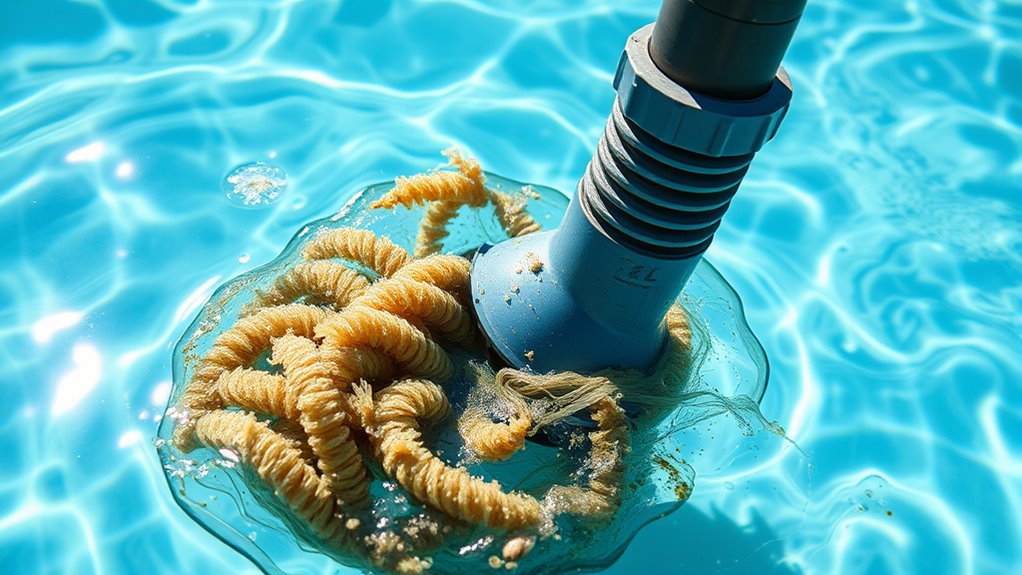
Neglecting regular maintenance and cleaning can quickly undermine the effectiveness of your suction pool cleaner. If you skip routine tasks like checking and cleaning the filter, debris can clog the system, reducing its suction power. Additionally, ignoring pool chemical balancing can lead to imbalanced pH levels, making algae prevention harder and increasing the chances of algae buildup. Regularly inspect and clean your cleaner’s parts to ensure best performance. Maintaining proper chemical levels keeps algae at bay and prevents debris from sticking to the cleaner’s components. Failing to perform these simple yet essential tasks can cause your cleaner to work harder and less efficiently, ultimately leading to more frequent breakdowns and higher maintenance costs. Staying aware of skincare ingredients and their effects can help you choose the right products to support your pool’s health. Incorporating professional cleaning services into your routine can also help maintain optimal pool conditions, reducing the chances of issues arising. Regularly checking the filter replacement indicators ensures your cleaner operates at peak efficiency, minimizing downtime. Proper filter maintenance can prevent clogging and extend the lifespan of your equipment. Stay proactive to keep your pool cleaner running smoothly.
Using the Wrong Suction Settings
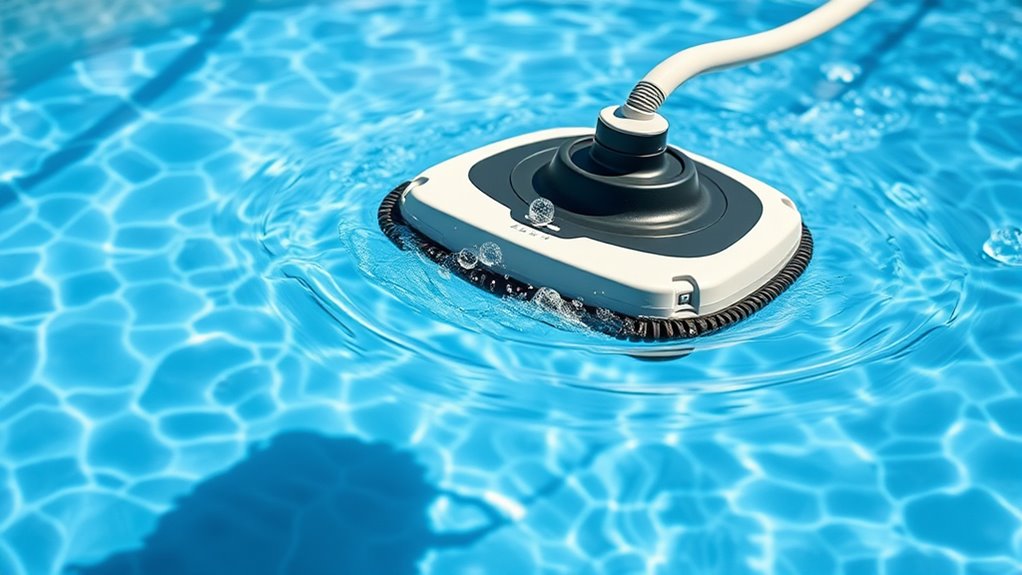
Using the wrong suction settings can prevent your cleaner from working effectively. If the power is too low, it won’t pick up debris properly, but if it’s too high, it may cause damage or unnecessary wear. Adjusting the settings correctly guarantees your pool stays clean and the device operates smoothly. Proper maintenance and adjustment of equipment can also improve performance and extend the lifespan of your pool cleaner. Additionally, understanding the automation technologies involved in pool cleaning can help you optimize your device’s use. Correctly configuring the suction power ensures efficient cleaning without harming the equipment or the pool surface. Informed settings adjustment based on the pool’s size and debris level can further enhance cleaning efficiency. Proper application of glycolic acid can also enhance skin health by promoting cell turnover and exfoliation.
Incorrect Power Levels
Setting the right suction power is essential for effective pool cleaning, but many people make the mistake of choosing the wrong level. Incorrect power levels can hinder debris pickup and strain your cleaner. Proper power level adjustments ensure ideal suction without damaging your pool surface or wasting energy. Here’s a quick guide:
| Power Level | Suitable for | Common Suction Setting Errors |
|---|---|---|
| Low | Fine debris, delicate surfaces | Setting too low, missing debris |
| Medium | General cleaning | Overlooking tougher debris |
| High | Heavy debris, rough surfaces | Excessive power, damaging liner |
| Max | Stubborn debris | Overuse, unnecessary energy drain |
| Off | During maintenance | Forgetting to turn on |
Avoid these suction setting errors by matching power levels to cleaning needs for the best results. Additionally, understanding IRA tax laws can help you plan withdrawals effectively to maximize your savings. Properly calibrating your cleaner’s power levels ensures a more efficient and longer-lasting cleaning process.
Ineffective Debris Pickup
Choosing the right suction settings directly impacts how well your pool cleaner picks up debris. If the suction is too low, it may struggle to lift leaves, dirt, or small particles, leaving your pool less clean. Conversely, excessive suction can cause the cleaner to stick or move inefficiently. Adjusting for pool chemistry and water temperature is essential; warmer water and imbalanced chemistry can affect debris looseness and water viscosity, influencing suction effectiveness. Regularly check and fine-tune your suction level based on debris type and pool conditions. Proper settings ensure ideal debris pickup, saving you time and effort. Additionally, understanding pool chemistry and its effects on water viscosity helps optimize the suction power for better cleaning results. Remember, mastering your suction settings helps maintain a cleaner pool and prolongs your cleaner’s lifespan. Ensuring your equipment is properly calibrated according to manufacturer recommendations can also prevent common issues and improve overall performance. Paying attention to water temperature and adjusting your settings accordingly can further enhance cleaning efficiency. Incorporating AI-driven diagnostics can also assist in identifying optimal settings for different pool environments.
Not Securing the Hoses Correctly
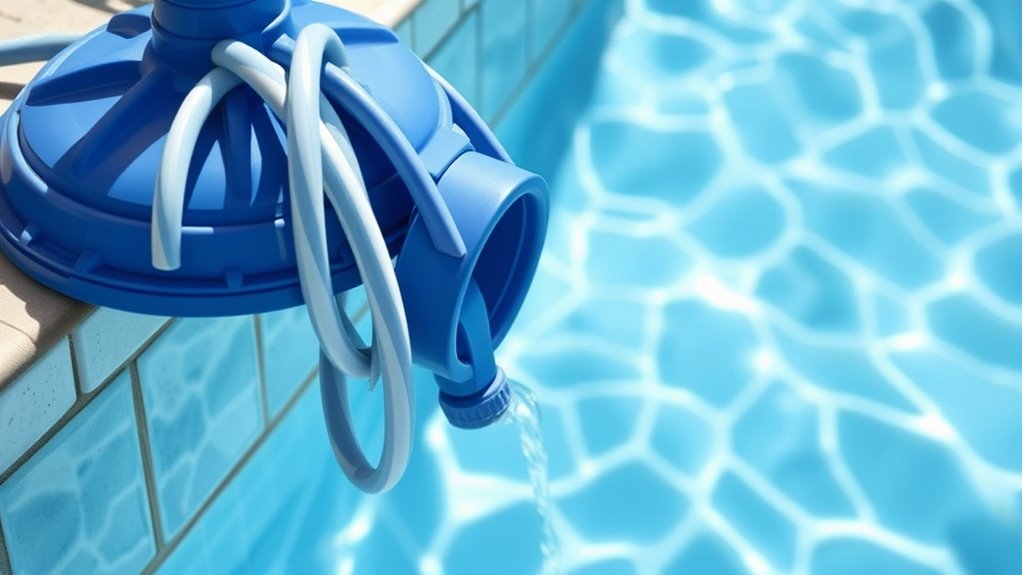
If the hoses aren’t secured properly, your suction pool cleaner won’t work effectively. A loose or incomplete hose connection can cause air leaks, reducing suction power and leaving debris behind. Make sure each hose segment clicks securely into place, creating a tight seal. Check that the hoses are connected properly to both the skimmer or dedicated suction port and the cleaner itself. Also, ensure the hoses are free of kinks or twists that could hinder water flow. When the hoses are firm, the cleaner can glide smoothly over the pool surface, maintaining consistent suction and coverage. Proper hose connection not only improves cleaning efficiency but also prevents the cleaner from detaching or getting stuck. Take the time to secure your hoses correctly before starting your pool cleaning session.
Overlooking Pool Debris and Obstructions

Even with secure hose connections, overlooking pool debris and obstructions can hinder your suction pool cleaner’s performance. Debris like leaves or twigs can block the cleaner’s path, reducing efficiency. Obstructions such as toys or algae build-up can also cause the cleaner to miss spots or get stuck. To keep your pool clean and properly balanced, regularly check for debris, ensuring your pool’s chemical balance supports algae prevention. A balanced pool minimizes algae growth, which can clog filters and hinder cleaning.
Even with secure hoses, debris and obstructions can reduce your pool cleaner’s effectiveness.
Here are three tips:
- Clear leaves and debris from the pool surface daily.
- Check for and remove obstructions before starting the cleaner.
- Maintain proper chemical levels to prevent algae buildup and keep the water clear.
Neglecting to Check for Leaks or Damage
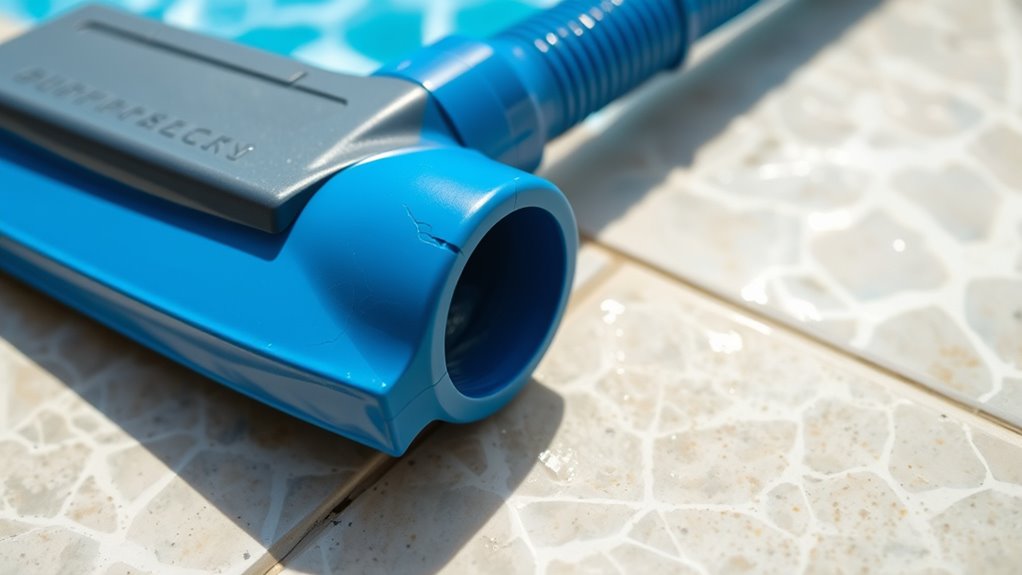
You need to regularly inspect your cleaner for leaks or visible damage to keep it working efficiently. If you notice any issues, repair them promptly to prevent further problems. Skipping these checks can lead to decreased suction and possible equipment failure.
Regular Leak Inspections
Regular leak inspections are essential to catch damage or leaks early on before they cause more serious problems. If you ignore leaks, your suction pool cleaner may not function properly, and your pool’s chemical balancing can become disrupted. Plus, leaks can lead to water waste and higher energy costs. To stay on top of things:
- Check hoses and connections for cracks or drips regularly.
- Inspect the seals and fittings for any signs of wear or damage.
- During seasonal pool cover management, ensure no leaks develop around cover edges that might affect your cleaner’s operation.
Repair Promptly When Needed
Neglecting to repair leaks or damage promptly can lead to more serious issues with your suction pool cleaner and pool system. Small leaks can cause loss of suction, making cleaning less effective. Damage might also impact water temperature management and disrupt pool chemical balancing, leading to algae growth or scaling. To prevent costly repairs, regularly inspect your cleaner for cracks or worn parts. Use this quick reference:
| Issue | Solution |
|---|---|
| Leaks or cracks | Seal or replace damaged parts |
| Worn hoses or seals | Replace to restore suction |
| Damage to brushes or wheels | Repair or replace immediately |
Addressing issues quickly keeps your cleaner running efficiently, saves energy, and maintains optimal water conditions.
Check for Visible Damage
Visually inspecting your suction pool cleaner regularly is essential to catch damage early. Small tears, cracks, or leaks can develop over time, especially if pool chemistry or water temperature fluctuates. Ignoring visible damage can reduce cleaning efficiency and cause further issues. To stay ahead, check your cleaner for:
- Leaks or tears in hoses or seals that might let debris escape
- Cracks or damage on the body caused by debris or temperature shifts
- Worn or brittle parts that could break during operation
Pay close attention after heavy storms or temperature changes, as these can accelerate damage. Regular visual checks help ensure your cleaner functions properly, saving you time and preventing costly repairs. Keep an eye out for signs of wear to maintain excellent pool cleanliness.
Running the Cleaner for Excessive Periods

Running your suction pool cleaner for too long can actually cause more harm than good. Overuse increases energy consumption unnecessarily, raising your utility bills without providing extra cleaning benefits. Continuous operation can also wear out parts faster, leading to costly repairs or replacements. Additionally, extended cleaning sessions might disrupt the pool’s overall cleaning frequency, making it less efficient in maintaining clarity. Instead of running the cleaner nonstop, set appropriate time limits based on your pool’s size and debris level. Regular, moderate cleaning sessions ensure the cleaner works effectively while conserving energy and prolonging its lifespan. Remember, more isn’t always better; strategic use helps keep your pool clean without unnecessary expenses or damage.
Improperly Connecting the Cleaner to the Pool’s Pump
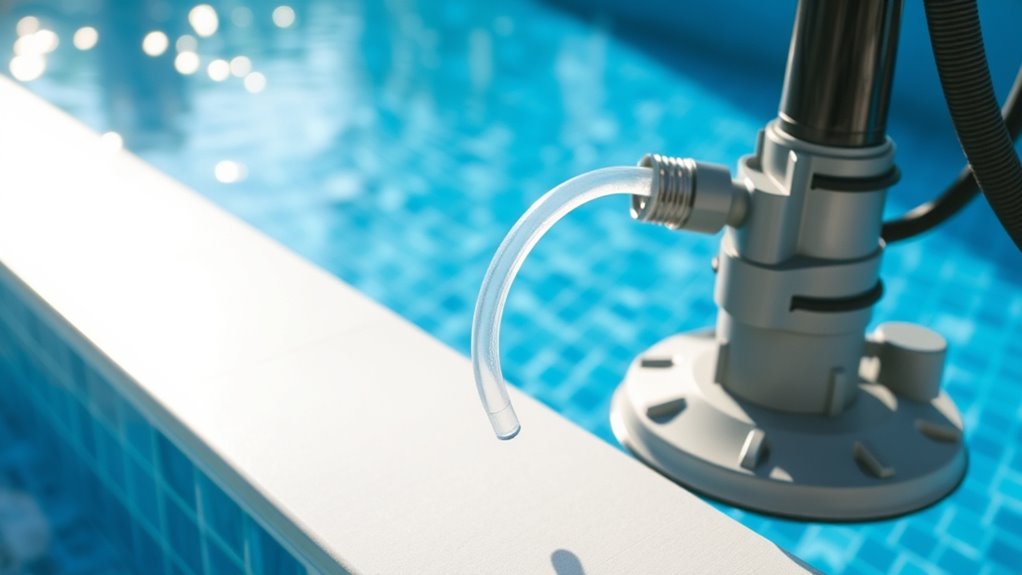
Make certain your pool’s pump is compatible with your cleaner to avoid flow issues. Double-check that all hose connections are secure to prevent leaks and loss of suction. Properly attaching the cleaner ensures it works efficiently without putting extra strain on your pump.
Check Pump Compatibility
Ensuring your suction pool cleaner connects properly to the pool’s pump is essential for effective operation. An incompatible pump can reduce cleaning efficiency and cause damage. First, check that your pump’s flow rate matches your cleaner’s requirements; too high or low can hinder performance. Second, verify that the pool’s water temperature and chemical levels won’t affect the pump’s operation or plastic components of the cleaner. Third, make sure the pump’s pressure is within the recommended range, as imbalances can prevent proper suction. Avoid forcing connections or using incompatible parts. Proper pump compatibility guarantees your cleaner functions smoothly, saving you time and preventing costly repairs caused by improper setup. Always refer to the manufacturer’s specifications to get it right.
Secure Hose Attachments
Securely attaching the hose to your pool’s pump is essential for proper suction and effective cleaning. If the hose isn’t firmly connected, you risk loss of suction, poor cleaning performance, and potential leaks. To guarantee attachment safety, double-check all fittings and clamps. Proper hose security prevents disconnections during operation. Use the following table to verify your setup:
| Connection Point | Check for | Tips for Secure Attachment |
|---|---|---|
| Pump inlet | Firm fit | Tighten clamps firmly |
| Hose to cleaner | No leaks | Ensure hose is fully inserted |
| End fittings | Secure | Use additional clamps if needed |
Forgetting to Adjust for Pool Shape and Size
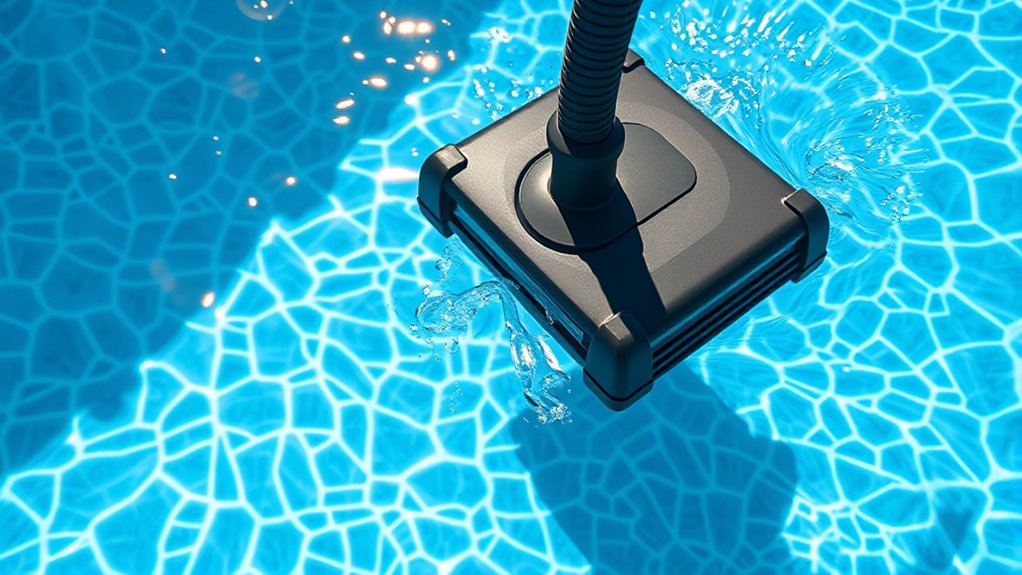
Many pool owners overlook the importance of adjusting their suction pool cleaner to fit the specific shape and size of their pool. Without proper size adjustment, your cleaner may miss spots or get stuck. To guarantee ideal cleaning, consider these key points:
- Assess Pool Shape: Different shapes, like oval or kidney, require different cleaning patterns. Adjust the cleaner’s path accordingly.
- Set Correct Size Adjustment: If your cleaner has a size setting, calibrate it to match your pool’s dimensions for thorough coverage.
- Monitor Coverage: Keep an eye on the cleaner’s movement to identify areas it may be missing due to incorrect adjustments.
Ignoring these steps can lead to inefficient cleaning and wasted time. Proper pool shape and size adjustment make a big difference in cleaning performance.
Ignoring Manufacturer’s Instructions and Recommendations
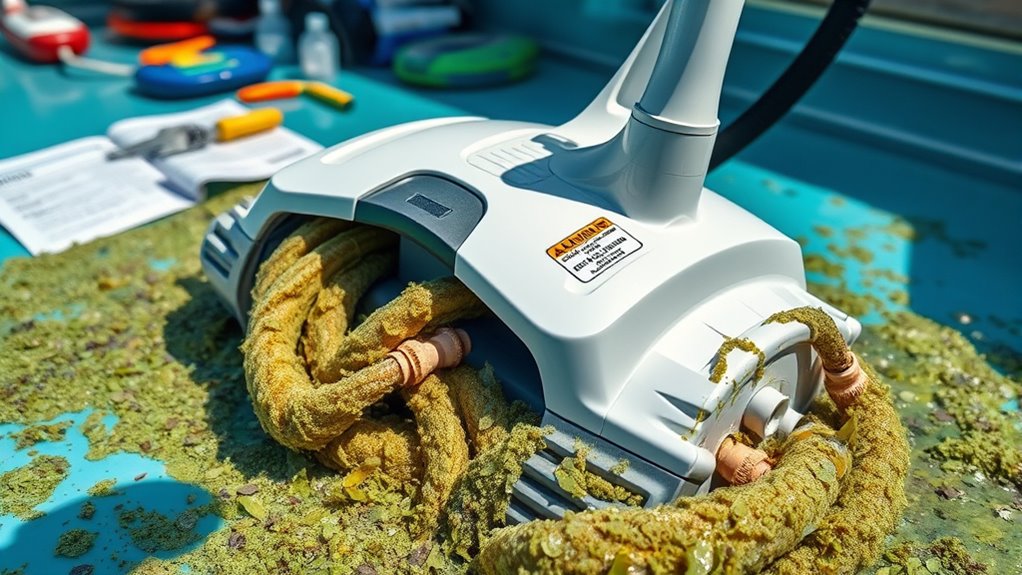
Ignoring the manufacturer’s instructions and recommendations can lead to ineffective cleaning and potential damage to your pool cleaner. Without proper guidance, you might overlook important details like adjusting for pool chemistry or specific features of your cleaner. This lack of user familiarity can result in improper setup, reducing cleaning efficiency, or even causing mechanical issues. Following the instructions ensures you understand how to optimize your pool’s chemistry, which directly impacts the cleaner’s performance. Neglecting these guidelines might also cause you to miss recommended maintenance routines, shortening your cleaner’s lifespan. Always read and adhere to the manufacturer’s recommendations to maximize your cleaner’s effectiveness, maintain proper pool chemistry, and avoid costly repairs. Proper knowledge makes your cleaning routine smoother and more successful.
Frequently Asked Questions
How Often Should I Replace Parts of My Suction Pool Cleaner?
You should replace parts of your suction pool cleaner based on its maintenance schedule and signs of wear. Typically, check the brushes, hoses, and filters every few months, and replace them if they show cracks, tears, or reduced performance. Regular part replacement guarantees ideal cleaning and prevents breakdowns. Follow the manufacturer’s guidelines for your specific model, and stay proactive with maintenance to keep your cleaner functioning efficiently.
Can I Use a Suction Pool Cleaner on All Pool Types?
You can usually use a suction pool cleaner on most pool surfaces, but check your cleaner’s manufacturer guidelines to be certain. It works well on concrete, vinyl, and fiberglass pools. Just make certain your water chemistry is balanced to prevent damage and optimize cleaning. Avoid using it on delicate surfaces like painted finishes or tiles with loose grout, as improper use could cause surface damage.
What Safety Precautions Are Necessary When Operating a Suction Pool Cleaner?
Oh, the irony of neglecting pool safety when operating a suction cleaner! You should always check your equipment, guarantee proper operator training, and keep kids and pets away during cleaning. Never bypass safety features or rush the process—these precautions protect you from potential hazards. Remember, a safe operator is an effective one, so follow all safety guidelines to enjoy a clean pool without risking accidents or injuries.
How Do I Troubleshoot if the Cleaner Is Not Moving Properly?
If your pool cleaner isn’t moving properly, you should troubleshoot the issues by checking for clogs or debris in the hoses and ensuring the skimmer is clean. Make sure the hoses are connected tightly and that the suction is strong enough. Inspect for leaks or blockages, and verify that the cleaner’s wheels or tracks aren’t jammed. These troubleshooting steps help resolve common pool cleaner issues quickly and restore proper movement.
Is It Necessary to Remove the Cleaner After Each Use?
You might think removing your suction pool cleaner after each use is unnecessary, but it’s actually a smart part of your maintenance schedule. Removing it prevents damage and buildup, extending its lifespan. Plus, storage tips like rinsing and drying help keep it in top shape. So, yes, taking it out after each use is worth the effort, ensuring your cleaner works efficiently and lasts longer.
Conclusion
By steering clear of these common pitfalls, you’ll keep your pool cleaner sailing smoothly through crystal-clear waters. Think of it as giving your trusty helper the right map and tools—so it can glide effortlessly, avoiding rough waters and hidden rocks. With attention and care, your cleaner becomes a loyal captain, ensuring your pool stays pristine and inviting. Keep these tips in mind, and let your pool sparkle like a gem, ready for every splash and swim.
